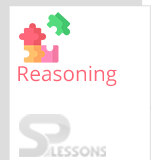 Description
Description
Assertion and reason test intends to judge the candidate's information and with it, capacity to reason out effectively.
In this test, two explanations/statements referred to as the Assertion(A) and Reason(R) separately are given.
Five different cases on these are given and the correct one is to be selected by the candidate.
Reasoning Ability -BANKING|SSC|RAILWAYS|INSURANCE|RECRUITMENT EXAMS – EBOOKS
 Concept
Concept
Assertion means a statement and reason means an explanation about that particular statement.
Given question is called as stem and the options are called as alternatives.
Stem of the question becomes two statements i.e. Assertion and Reason.
So, here relate the reason to the assertion with adjectives like because, if, so that, and check if the reason is making any sense towards assertion.
Assertion reason sort question has these five diverse cases. They are:
1. Both statement and reason are valid, reason is right clarification of assertion.
2. Both statement and reason are valid however reason is not a right clarify of assertion.
3. Assertion is valid however reason is false.
4. Assertion is false however reason is valid.
5. Both are false.
 Model
Problems
Model
Problems
Model 1: Assertion (A): I came late today.
Reason (R): It was raining.
There are two statements namely Assertion and Reason. Choose the correct answer from below:
a) If both A and R are true and R is the correct explanation of A.
b) If both A and R are true and R is not the correct explanation of A.
c) If A is true but R is false.
d) If A is false but R is true.
e) If both A and R are false.
Solution:
Given statements are:
Assertion (A): I came late today.
Reason (R): It was raining.
If the reason is related to the assertion with 'because' i.e. I came late today because it was raining. So, it makes sense.
Here reason is correct explanation of assertion.
So, option(a) is the right one.
Model 2: Assertion (A): Legumes revive the soil fertility
Reason (R): Microbes in the root nodules of legumes fix the atmospheric nitrogen.
There are two statements namely Assertion and Reason. Choose the correct answer from below:
a) If both A and R are true and R is the correct explanation of A.
b) If both A and R are true and R is not the correct explanation of A.
c) If A is true but R is false.
d) If A is false but R is true.
e) If both A and R are false.
Solution:
Given statements are:
Assertion (A): Legumes revive the soil fertility
Reason (R): Microbes in the root nodules of legumes fix the atmospheric nitrogen.
So, the root knobs of leguminous plants contain nitrogen settling microscopic organisms which ingest the barometric al nitrogen and convert it into nitrogenous mixes helpful for the plants restoring soil ripeness.
Hence, by relating reason with assertion, both A and R are true and R is correct explanation of A.
Therefore, option(a) is right answer.
Model 3: Assertion (A): Bangladesh imports jute from India.
Reason (R): Bangladesh has most of the jute mills.
There are two statements namely Assertion and Reason. Choose the correct answer from below:
a) If both A and R are true and R is the correct explanation of A.
b) If both A and R are true and R is not the correct explanation of A.
c) If A is true but R is false.
d) If A is false but R is true.
e) If both A and R are false.
Solution:
Given that:
Assertion (A): Bangladesh imports jute from India.
Reason (R): Bangladesh has most of the jute mills.
So, When Bangladesh was created after partition of India, the areas of jute production went to Bangladesh while jute mills were left in India. So, India imports jute from Bangladesh.
Thus both A and R are false.
Therefore, option(e) is the right choice.
Model 4: Assertion (A): Travellers in a water craft are not permitted to stand.
Reason (R): This may raise the focal point of gravity of the water craft and the water craft may topple over because of temperamental stability.
There are two statements namely Assertion and Reason. Choose the correct answer from below:
a) If both A and R are true and R is the correct explanation of A.
b) If both A and R are true and R is not the correct explanation of A.
c) If A is true but R is false.
d) If A is false but R is true.
e) If both A and R are false.
Solution:
Given that:
Assertion (A): Travellers in a water craft are not permitted to stand.
Reason (R): This may raise the focal point of gravity of the water craft and the water craft may topple over because of temperamental stability.
So, here R explains the A clearly.
Therefore, option(a) is right one.
Model 5: Assertion (A): Gold is used to make jewellery.
Reason (R): Gold is an alloy of silver and copper.
There are two statements namely Assertion and Reason. Choose the correct answer from below:
a) If both A and R are true and R is the correct explanation of A.
b) If both A and R are true and R is not the correct explanation of A.
c) If A is true but R is false.
d) If A is false but R is true.
e) If both A and R are false.
Solution:
Given that:
Assertion (A): Gold is used to make jewellery.
Reason (R): Gold is an alloy of silver and copper.
As the Gold is alloy of silver and copper, it is resistant and helpful in making jewellery.
Hence, reason explains the assertion clearly.
Therefore, option(a) is correct one.



